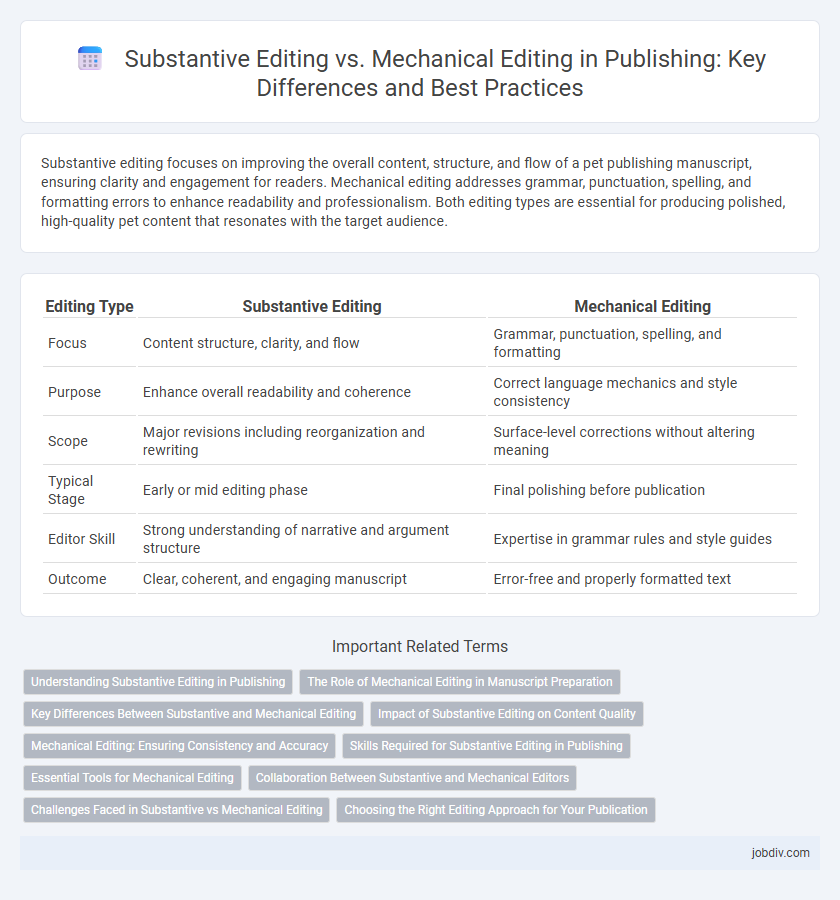Substantive editing focuses on improving the overall content, structure, and flow of a pet publishing manuscript, ensuring clarity and engagement for readers. Mechanical editing addresses grammar, punctuation, spelling, and formatting errors to enhance readability and professionalism. Both editing types are essential for producing polished, high-quality pet content that resonates with the target audience.
Table of Comparison
| Editing Type | Substantive Editing | Mechanical Editing |
|---|---|---|
| Focus | Content structure, clarity, and flow | Grammar, punctuation, spelling, and formatting |
| Purpose | Enhance overall readability and coherence | Correct language mechanics and style consistency |
| Scope | Major revisions including reorganization and rewriting | Surface-level corrections without altering meaning |
| Typical Stage | Early or mid editing phase | Final polishing before publication |
| Editor Skill | Strong understanding of narrative and argument structure | Expertise in grammar rules and style guides |
| Outcome | Clear, coherent, and engaging manuscript | Error-free and properly formatted text |
Understanding Substantive Editing in Publishing
Substantive editing in publishing involves comprehensive revision that improves the content's structure, clarity, and overall flow by addressing plot development, character consistency, and thematic depth. It differs from mechanical editing, which focuses on grammar, punctuation, and formatting accuracy. Understanding substantive editing is crucial for authors aiming to enhance narrative coherence and reader engagement before finalizing a manuscript.
The Role of Mechanical Editing in Manuscript Preparation
Mechanical editing plays a critical role in manuscript preparation by ensuring consistency in grammar, punctuation, spelling, and formatting. This process eliminates surface errors that can distract readers and undermine the author's credibility, thereby enhancing the manuscript's overall readability and professionalism. Mechanical editing supports substantive editing by providing a clean, error-free foundation for addressing content, structure, and style improvements.
Key Differences Between Substantive and Mechanical Editing
Substantive editing involves in-depth content evaluation, focusing on structure, flow, clarity, and overall narrative coherence, ensuring the manuscript effectively conveys its message to the target audience. Mechanical editing targets grammar, punctuation, spelling, and syntax errors, refining the text's technical accuracy without altering the core ideas or organization. Key differences include the scope of edit--substantive editing reshapes content while mechanical editing polishes language mechanics for readability and correctness.
Impact of Substantive Editing on Content Quality
Substantive editing significantly enhances content quality by improving structure, clarity, and coherence, ensuring the core message is effectively communicated to the target audience. It addresses inconsistencies in tone, flow, and logical progression, which mechanical editing, focused on grammar and punctuation, typically overlooks. This deeper level of editing transforms raw manuscripts into polished, compelling narratives that engage readers and elevate the overall impact of the publication.
Mechanical Editing: Ensuring Consistency and Accuracy
Mechanical editing focuses on ensuring consistency and accuracy by meticulously correcting grammar, punctuation, spelling, and formatting errors throughout the manuscript. This stage refines the text's technical details to adhere to style guides such as Chicago, APA, or MLA, enhancing overall readability and professionalism. By standardizing elements like citation formats, abbreviations, and typographical conventions, mechanical editing helps maintain a polished and credible publication.
Skills Required for Substantive Editing in Publishing
Substantive editing in publishing demands advanced skills in content analysis, narrative structure evaluation, and coherence enhancement to ensure the manuscript's overall clarity and impact. Proficiency in critical thinking, subject knowledge, and a deep understanding of genre conventions enables editors to refine ideas, improve logical flow, and reinforce thematic elements. Mastery of language nuances and the ability to provide constructive feedback distinguish substantive editing from mechanical editing, which primarily involves grammar, punctuation, and formatting corrections.
Essential Tools for Mechanical Editing
Essential tools for mechanical editing include grammar checkers, spell checkers, and style guides that ensure accuracy in punctuation, spelling, and syntax. Software like Grammarly, Hemingway Editor, and ProWritingAid streamline the identification and correction of mechanical errors, enhancing overall document clarity. These tools support editors by automating routine corrections, allowing focus on content refinement in substantive editing.
Collaboration Between Substantive and Mechanical Editors
Collaboration between substantive and mechanical editors enhances the publishing process by combining deep content expertise with meticulous attention to grammar, punctuation, and formatting. Substantive editors focus on structure, clarity, and overall narrative coherence, while mechanical editors ensure consistency in language conventions and style guidelines. This integrated approach improves manuscript quality, streamlines revisions, and meets both editorial standards and audience expectations efficiently.
Challenges Faced in Substantive vs Mechanical Editing
Substantive editing challenges primarily involve maintaining the author's voice while restructuring content for clarity, coherence, and logical flow, which requires deep subject-matter expertise and creative judgment. Mechanical editing, by contrast, demands meticulous attention to grammar, punctuation, spelling, and adherence to style guides, often requiring consistency checks across large manuscripts. Balancing these distinct demands highlights the complexity of the editorial process in publishing, as substantive editing enhances narrative quality while mechanical editing ensures technical accuracy.
Choosing the Right Editing Approach for Your Publication
Substantive editing focuses on enhancing the overall structure, content clarity, and flow of a manuscript, making it ideal for developmental improvements and complex narrative revisions. Mechanical editing addresses grammar, punctuation, spelling, and syntax errors, ensuring technical accuracy and consistency before publication. Selecting the right editing approach depends on the manuscript's current stage and specific needs, balancing comprehensive content enhancement with precise language correction.
Substantive Editing vs Mechanical Editing Infographic

 jobdiv.com
jobdiv.com